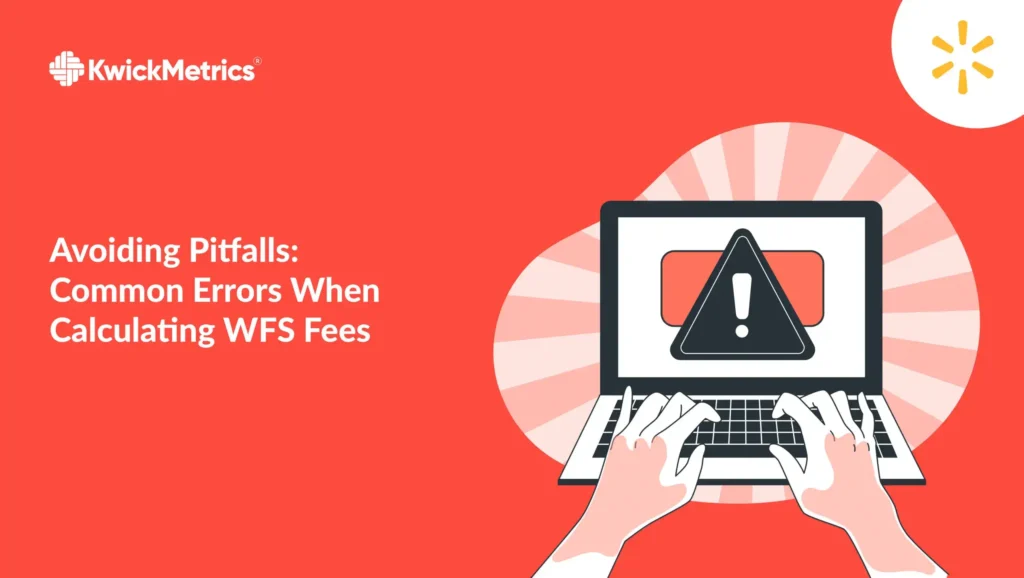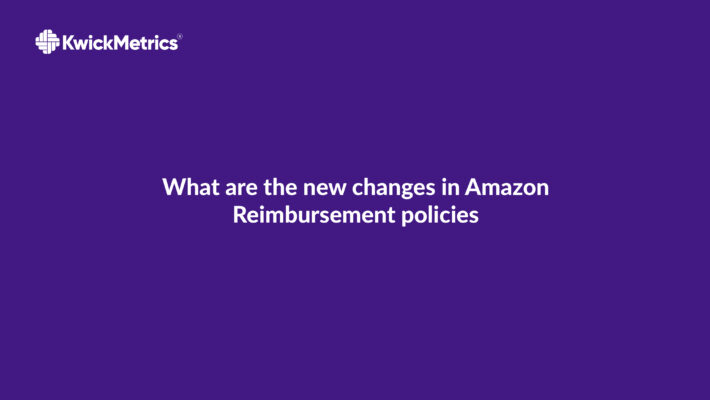Avoiding Pitfalls: Common Errors When Calculating WFS Fees

Table of Contents
- WFS fees- what it is?
- WFS fee errors- what it is?
- #WFS Fees Error 1: Misunderstanding Fee Components
- KwickMetrics - The Business Intelligence and Analytics Tool
- #WFS Fees Error 2: Incorrect Product Dimensions
- #WFS Fees Error 3: Ignoring Fee Updates and Changes
- Try Our KwickMetrics - One Tool with Multiple Solutions!
- #WFS Fees Error 4: Manual Calculation Errors
- #WFS Fees Error 5: Lack of Regular Fee Audits
- FAQs Related to WFS Fee Errors
- Conclusion
- Explore Our Features!
Attention, Walmart Sellers! Are you navigating the maze of logistics and fulfillment services, seeking to optimize your operations and enhance your profitability? If so, you’re likely familiar with the convenience and efficiency offered by the Walmart Warehousing Fulfillment Service (WFS). However, amidst the hustle and bustle of online retail, it’s easy to stumble upon hidden pitfalls that can impact your bottom line. 1
In this comprehensive guide, we’ll embark on a journey to uncover the intricacies of WFS fees and unveil the common errors that even the savviest sellers may encounter. Whether you’re a seasoned e-commerce veteran or a newcomer to the world of online retail, understanding and avoiding these pitfalls is essential for maximizing your success on the Walmart platform.
So, fasten your seatbelt, dear sellers, as we delve into the world of WFS fees and equip you with the knowledge and insights needed to navigate this complex landscape smoothly. let’s embark on this enlightening journey towards fulfillment excellence, ensuring your path is clear of any costly missteps.
WFS fees- what it is?
WFS fees, encompass the charges associated with utilizing the Walmart Warehousing Fulfillment Service. This service allows sellers to store their inventory in the Walmart fulfillment centers, where Walmart handles the picking, packing, and shipping of orders on behalf of the seller.
These fees typically include various components such as storage fees, fulfillment fees, and additional charges for optional services like labeling, special packaging, or expedited shipping. Essentially, WFS fees cover the costs incurred by Walmart for storing, managing, and fulfilling sellers’ inventory, enabling sellers to leverage Walmart’s extensive logistics network and infrastructure to streamline their operations and enhance their customer experience.
Key Takeaway:
Understanding WFS Fees: Delve into the intricacies of Walmart Fulfillment Services (WFS) fees, covering storage, fulfillment, and additional charges.
WFS fee errors- what it is?
WFS fees errors refer to the common mistakes and inaccuracies that sellers may encounter when calculating or managing their Walmart Fulfillment Services fees. These errors can lead to unexpected costs, financial setbacks, and operational inefficiencies if not addressed promptly. Understanding and mitigating these errors is crucial for Walmart sellers to optimize their fulfillment operations and maximize profitability.
#WFS Fees Error 1: Misunderstanding Fee Components
One of the primary pitfalls encountered by Walmart sellers is misunderstanding the intricate components that contribute to WFS fees. This error often stems from a lack of clarity regarding the various charges associated with storage, fulfillment, and additional services provided by the Walmart Warehousing Fulfillment Service.
Failure to grasp these fee components accurately can result in miscalculations, leading to unexpected costs and financial strain on sellers’ businesses. Therefore, gaining a comprehensive understanding of the fee structure is essential for navigating Walmart Fulfillment Services successfully.
Example:
A seller may overlook the distinction between storage fees for standard versus oversized items in Walmart Fulfillment Services (WFS). Consequently, they might underestimate the costs associated with storing larger products, leading to financial surprises when they receive their billing statements. This misunderstanding underscores the importance of carefully evaluating fee components to ensure accurate financial planning within the WFS ecosystem.
KwickMetrics - The Business Intelligence and Analytics Tool
Explore 14-day free trial! No credit card required, cancel at any time.
#WFS Fees Error 2: Incorrect Product Dimensions
One common error in understanding WFS fees involves incorrect product dimensions. Sellers may inadvertently underestimate the size or weight of their items, leading to inaccuracies in storage and fulfillment cost calculations. This discrepancy can result in overcharges for storage space or shipping fees, negatively impacting profitability.
It’s crucial for sellers to accurately measure and provide product dimensions to Walmart Fulfillment Services to avoid such errors and ensure precise cost assessments. Regularly updating product information can also help prevent these discrepancies from occurring.
Example:
If a seller lists a product with incorrect dimensions, estimating it to be 10x10x10 inches instead of its actual size of 12x12x12 inches, they may incur additional fees. Let’s assume the standard rate for storing items under 1 cubic foot is $0.50 per month, but for items exceeding this, it’s $1.00 per cubic foot. With the incorrect dimensions, they might wrongly calculate the storage cost as $0.50 instead of $1.00 per month, resulting in a potential monthly overcharge of $0.50 per unit.
#WFS Fees Error 3: Ignoring Fee Updates and Changes
Another critical error in managing WFS fees is ignoring updates and changes in the fee structure imposed by Walmart. Sellers who fail to stay informed about adjustments in storage rates, fulfillment charges, or service fees may inadvertently underestimate their expenses.
This oversight can lead to unexpected financial burdens and hinder accurate budgeting for WFS operations. Regularly monitoring announcements and policy updates from Walmart and adapting strategies accordingly is essential to avoid this error and maintain cost-effective fulfillment operations.
Example:
If Walmart announces an increase in storage fees for oversized items within WFS, sellers who overlook this update may continue to calculate costs based on outdated rates. Consequently, they could end up underestimating their expenses, leading to financial strain on their businesses. Staying vigilant and promptly adjusting pricing strategies in response to fee changes is crucial for maintaining profitability within Walmart Fulfillment Services.
How to keep myself updated about latest WFS fees?
Try Our KwickMetrics - One Tool with Multiple Solutions!
#WFS Fees Error 4: Manual Calculation Errors
A common mistake in managing WFS fees involves manual calculation errors. Sellers who rely on manual calculations for determining storage, fulfillment, or additional service fees may make mistakes that lead to inaccurate financial assessments.
These errors can result from human oversight, miscalculations, or data entry mistakes, potentially causing financial losses or discrepancies in budgeting. Utilizing automated tools or double-checking calculations can help mitigate this risk and ensure accurate fee assessments within Walmart Fulfillment Services.
Example:
If a seller manually calculates fulfillment fees for 100 orders at $3.50 each, but mistakenly inputs $4.50 instead, they could overcharge customers by $100. This error stems from a simple miscalculation but can have significant financial implications. Employing automated systems or double-checking calculations could prevent such mistakes and maintain accurate billing within Walmart Fulfillment Services.
#WFS Fees Error 5: Lack of Regular Fee Audits
An error often seen in managing WFS fees is the lack of regular fee audits by sellers. Failing to periodically review and reconcile charges from Walmart Fulfillment Services can result in unnoticed overcharges or discrepancies.
Without audits, sellers may miss opportunities to identify billing errors, negotiate better rates, or optimize their fulfillment costs. Implementing a routine schedule for fee audits can help sellers maintain financial accuracy and efficiency within their WFS operations.
Example:
A seller who neglects to review their monthly WFS billing statement may overlook a discrepancy where they were charged for 100 units of storage instead of the actual 90 units stored. With a storage rate of $0.50 per unit per month, this oversight could result in an unnecessary charge of $5. Regular fee audits would catch such errors, allowing sellers to rectify them promptly and prevent financial losses.
Key Takeaway:
Avoiding Common Errors: Learn about common pitfalls like misunderstanding fee components, incorrect product dimensions, and manual calculation errors.
FAQs Related to WFS Fee Errors
Q. What should I do if I suspect an error in my WFS fees?
A. If you suspect an error in your WFS fee, it’s crucial to investigate promptly. Start by reviewing your billing statements and comparing them against your expectations and agreements. If you find discrepancies, reach out to Walmart’s support or your account manager to rectify the issue.
Q. How Walmart Sellers ensure accurate product dimensions to avoid WFS fee errors?
A. Walmart sellers can ensure accurate product dimensions by measuring the length, width, and height of their items carefully. They should round up to the nearest inch and consider packaging materials. Accurate measurements prevent errors in calculating fees for Walmart Fulfillment Services (WFS).
Q. What steps can I take to stay informed about WFS fee updates and changes?
A. To stay informed about fee updates and changes, regularly check Walmart’s official communications channels, such as seller portals, newsletters, or announcements. Additionally, consider joining relevant online communities or forums where sellers discuss updates and share insights.
Q. Are their tools or software available to help automate fee calculations and minimize errors?
A. Yes, several tools like KwickMetrics are available to help automate fee calculations and minimize errors in WFS operations. These tools can streamline processes, reduce manual input errors, and provide real-time insights into fees and expenses within Walmart Fulfillment Services.
Q. How often should I conduct fee audits to ensure accuracy and efficiency in my WFS operations?
A. It’s recommended to conduct fee audits regularly, ideally on a monthly basis or at least quarterly. Regular audits help identify any discrepancies or overcharges promptly, allowing you to address them and optimize your WFS operations for cost-effectiveness and efficiency.
Conclusion
In the labyrinth of Walmart’s Warehousing Fulfillment Service (WFS), steering clear of common WFS fee errors is paramount for e-commerce success. From misunderstanding fee components to neglecting updates, these pitfalls can derail profitability.
But fear not, dear sellers! By grasping the nuances of WFS fees and staying vigilant, you can navigate this landscape. Armed with knowledge and equipped with best practices, your journey towards fulfillment excellence on the Walmart platform is not just feasible but promising. So, embrace clarity, stay informed, and let your path be illuminated by prudent decision-making.
Happy selling!


